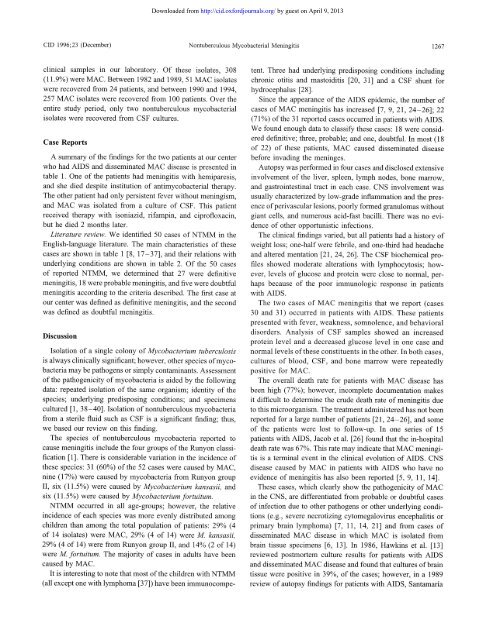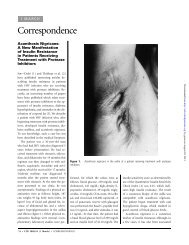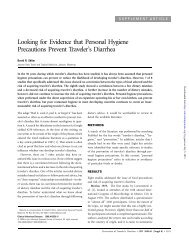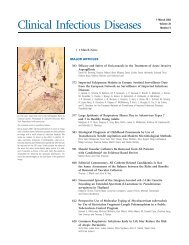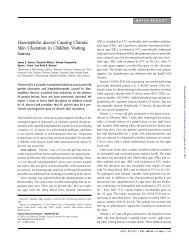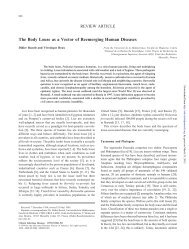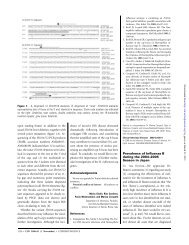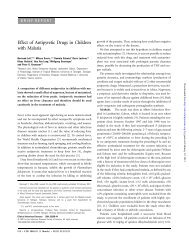Nontuberculous Mycobacterial Meningitis - Clinical Infectious ...
Nontuberculous Mycobacterial Meningitis - Clinical Infectious ...
Nontuberculous Mycobacterial Meningitis - Clinical Infectious ...
You also want an ePaper? Increase the reach of your titles
YUMPU automatically turns print PDFs into web optimized ePapers that Google loves.
em 1996;23 (December) Nontubercu1ous <strong>Mycobacterial</strong> <strong>Meningitis</strong> 1267<br />
clinical samples in our laboratory. Of these isolates, 308<br />
(11.9%) were MAC. Between 1982 and 1989, 51 MAC isolates<br />
were recovered from 24 patients, and between 1990 and 1994,<br />
257 MAC isolates were recovered from 100 patients. Over the<br />
entire study period, only two nontuberculous mycobacterial<br />
isolates were recovered from CSF cultures.<br />
Case Reports<br />
A summary of the findings for the two patients at our center<br />
who had AIDS and disseminated MAC disease is presented in<br />
table 1. One of the patients had meningitis with hemiparesis,<br />
and she died despite institution of antimycobacterial therapy.<br />
The other patient had only persistent fever without meningism,<br />
and MAC was isolated from a culture of CSF. This patient<br />
received therapy with isoniazid, rifampin, and ciprofloxacin,<br />
but he died 2 months later.<br />
Literature review. We identified 50 cases of NTMM in the<br />
English-language literature. The main characteristics of these<br />
cases are shown in table 1 [8, 17 -37], and their relations with<br />
underlying conditions are shown in table 2. Of the 50 cases<br />
of reported NTMM, we determined that 27 were definitive<br />
meningitis, 18 were probable meningitis, and five were doubtful<br />
meningitis according to the criteria described. The first case at<br />
our center was defined as definitive meningitis, and the second<br />
was defined as doubtful meningitis.<br />
Discussion<br />
Isolation of a single colony of Mycobacterium tuberculosis<br />
is always clinically significant; however, other species of my cobacteria<br />
may be pathogens or simply contaminants. Assessment<br />
of the pathogenicity of mycobacteria is aided by the following<br />
data: repeated isolation of the same organism; identity of the<br />
species; underlying predisposing conditions; and specimens<br />
cultured [1, 38-40]. Isolation of nontuberculous mycobacteria<br />
from a sterile fluid such as CSF is a significant finding; thus,<br />
we based our review on this finding.<br />
The species of nontuberculous mycobacteria reported to<br />
cause meningitis include the four groups of the Runyon classification<br />
[1]. There is considerable variation in the incidence of<br />
these species: 31 (60%) of the 52 cases were caused by MAC,<br />
nine (17%) were caused by mycobacteria from Runyon group<br />
II, six (11.5%) were caused by Mycobacterium kansasii, and<br />
six (11.5%) were caused by Mycobacterium fortuitum.<br />
NTMM occurred in all age-groups; however, the relative<br />
incidence of each species was more evenly distributed among<br />
children than among the total population of patients: 29% (4<br />
of 14 isolates) were MAC, 29% (4 of 14) were M kansasii,<br />
29% (4 of 14) were from Runyon group II, and 14% (2 of 14)<br />
were M fortuitum. The majority of cases in adults have been<br />
caused by MAC.<br />
It is interesting to note that most ofthe children with NTMM<br />
(all except one with lymphoma [37]) have been immunocompe-<br />
Downloaded from<br />
http://cid.oxfordjournals.org/ by guest on April 9, 2013<br />
tent. Three had underlying predisposing conditions including<br />
chronic otitis and mastoiditis [20, 31] and a CSF shunt for<br />
hydrocephalus [28].<br />
Since the appearance of the AIDS epidemic, the number of<br />
cases of MAC meningitis has increased [7, 9, 21, 24-26]; 22<br />
(71 %) ofthe 31 reported cases occurred in patients with AIDS.<br />
We found enough data to classify these cases: 18 were considered<br />
definitive; three, probable; and one, doubtful. In most (18<br />
of 22) of these patients, MAC caused disseminated disease<br />
before invading the meninges.<br />
Autopsy was performed in four cases and disclosed extensive<br />
involvement of the liver, spleen, lymph nodes, bone marrow,<br />
and gastrointestinal tract in each case. CNS involvement was<br />
usually characterized by low-grade inflammation and the presence<br />
of perivascular lesions, poorly formed granulomas without<br />
giant cells, and numerous acid-fast bacilli. There was no evidence<br />
of other opportunistic infections.<br />
The clinical findings varied, but all patients had a history of<br />
weight loss; one-half were febrile, and one-third had headache<br />
and altered mentation [21, 24, 26]. The CSF biochemical profiles<br />
showed moderate alterations with lymphocytosis; however,<br />
levels of glucose and protein were close to normal, perhaps<br />
because of the poor immunologic response in patients<br />
with AIDS.<br />
The two cases of MAC meningitis that we report (cases<br />
30 and 31) occurred in patients with AIDS. These patients<br />
presented with fever, weakness, somnolence, and behavioral<br />
disorders. Analysis of CSF samples showed an increased<br />
protein level and a decreased glucose level in one case and<br />
normal levels of these constituents in the other. In both cases,<br />
cultures of blood, CSF, and bone marrow were repeatedly<br />
positive for MAC.<br />
The overall death rate for patients with MAC disease has<br />
been high (77%); however, incomplete documentation makes<br />
it difficult to determine the crude death rate of meningitis due<br />
to this microorganism. The treatment administered has not been<br />
reported for a large number of patients [21,24-26], and some<br />
of the patients were lost to follow-up. In one series of 15<br />
patients with AIDS, Jacob et al. [26] found that the in-hospital<br />
death rate was 67%. This rate may indicate that MAC meningitis<br />
is a terminal event in the clinical evolution of AIDS. CNS<br />
disease caused by MAC in patients with AIDS who have no<br />
evidence of meningitis has also been reported [5, 9, 11, 14].<br />
These cases, which clearly show the pathogenicity of MAC<br />
in the CNS, are differentiated from probable or doubtful cases<br />
of infection due to other pathogens or other underlying conditions<br />
(e.g., severe necrotizing cytomegalovirus encephalitis or<br />
primary brain lymphoma) [7, 11, 14, 21] and from cases of<br />
disseminated MAC disease in which MAC is isolated from<br />
brain tissue specimens [6, 13]. In 1986, Hawkins et al. [13]<br />
reviewed postmortem culture results for patients with AIDS<br />
and disseminated MAC disease and found that cultures of brain<br />
tissue were positive in 39%, of the cases; however, in a 1989<br />
review of autopsy findings for patients with AIDS, Santamaria


